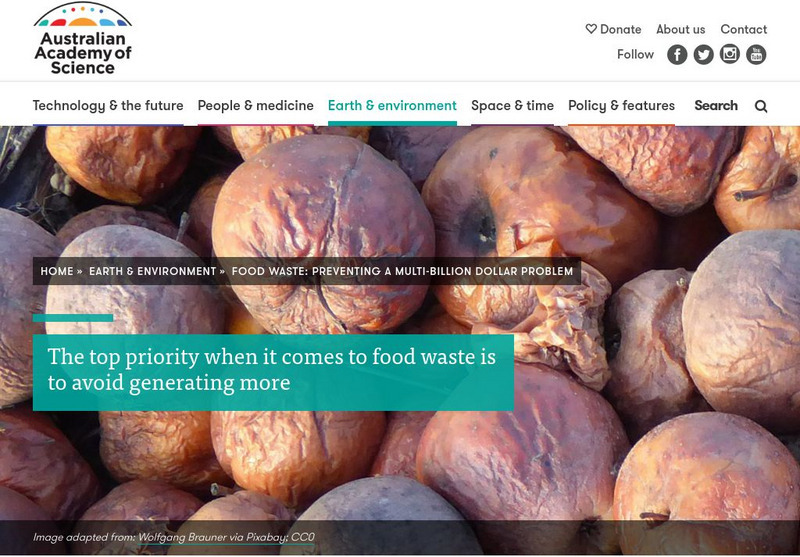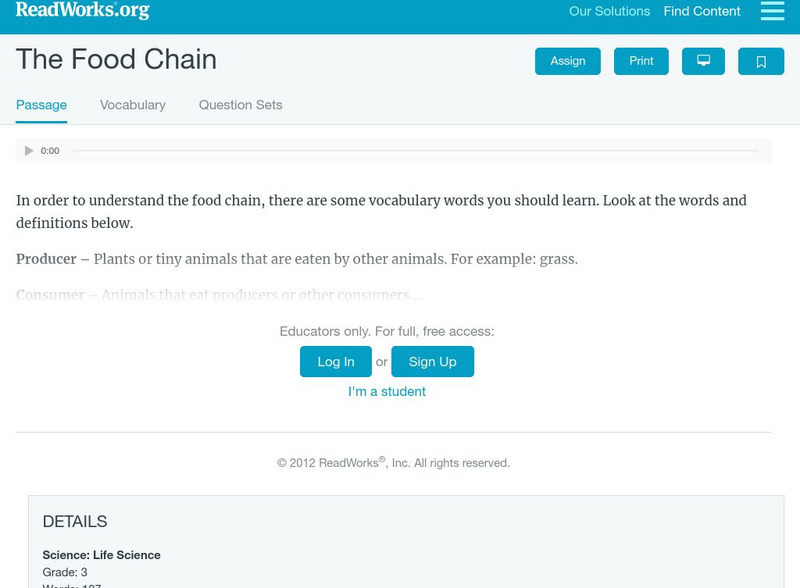Other
Virginia State Department of Agriculture/consumer Sciences: About Food Poisoning
This site about food poisoning discusses Staphylococcus Aureus - what it is, where the common sources of "staph" are, common symptoms, and what can be done to prevent contamination and infection.
Other
Australian Acad. Of Science: Food Waste: Preventing Multi Billion Dollar Problem
The top priority when it comes to food waste is to avoid generating more. Food waste includes all food intended for human consumption that never reaches us, as well as edible food that consumers throw away. As it rots in landfills, food...
Science Struck
Science Struck: Difference Between Food Chain and Food Web
Explains the characteristics of food chains and food web; the different levels of producers, consumers, and decomposers; and the differences between food chains and food webs. Includes charts and a Venn diagram comparing the two.
CK-12 Foundation
Ck 12: Fifth Grade Science: Life Science: The Flow of Energy in an Ecosystem
A module that explains what an ecosystem is and how energy and matter move through them. Students will look at the different roles of plants and animals and at ecological relationships in food chains and food webs.
Channel 4 Learning
4 Learning: Science Essentials: Interdependence and Adaptation
Article describes the importance of green plants and the ideal conditions they need to produce the food and oxygen people need to live.
University of Utah
University of Utah: Learning Center: learn.genetics: Great Salt Lake Food Web
Visualize how energy transfer takes place in two linked food chains, and how it demonstrates the interdependence organisms of the Great Salt Lake.
Cornell University
Cornell University: Hearth/home Economics Education
Housed at the Mann Library, this resource contains a comprehensive set of books and journals in the field of Home Economics, many available online. Each subject area in the field has a descriptive essay plus a bibliography related to...
Other
South Coast Today: Fast Food, Faster Calories
A personal account of eating at fast food restaurants. Learn how you can still eat at fast food restaurants without consuming all the calories you need in one meal.
Annenberg Foundation
Annenberg Learner: The Habitable Planet: Ecology Lab
Create the parameters of your own ecosystem by choosing which producers and consumers live there. Visualize how the food web operates and species populations change. This simulator mimics the food web within a typical ecosystem and gives...
Khan Academy
Khan Academy: Ap Us History: 1890 1945: The Age of Empire: The Progressive Era
The Progressive Era from the 1890s to the 1920s evolved as a response to the negative effects of industrialization. Reforms that emerged provided protections for workers and consumers and gave women voting rights. Backlash against the...
CK-12 Foundation
Ck 12: Life Science: Consumers and Decomposers
[Free Registration/Login may be required to access all resource tools.] Producers make their own food through photosynthesis. But many organisms are not producers and cannot make their own food, but must get their energy from other...
Science Struck
Science Struck: Examples of Tertiary Consumers
Explains what is meant by a tertiary consumer in a food chain and provides examples.
Science Struck
Science Struck: Learn All About the Ocean Food Chain
Read about the different predators, consumers, and producers that make up an ocean food chain.
Utah Education Network
Uen: Biological Energy Food Chain Practice
After reviewing the roles of consumers, producers and decomposers, you'll create your own food chains using pictures from magazines. The site also has 18 questions to see if you can identify the ecologic role played by various organisms.
Scholastic
Scholastic: Study Jams! Science: Ecosystems: Food Webs
A video and a short multiple-choice quiz on food webs that explains the difference between food webs and food chains, and the relationships that exist between organisms.
Scholastic
Scholastic: Study Jams! Science: Ecosystems: Food Chains
A video and a short multiple-choice quiz on food chains that explains how energy flows through the chain, beginning with plants.
Read Works
Read Works: The Food Chain
[Free Registration/Login Required] An informational text explaining important vocabulary involving the food chain. A question sheet is available to help students build skills in reading comprehension.
Project Britain
Primary Homework Help: Food Chains Quiz
Brush up on food chain vocabulary before taking this interactive quiz. Check the box for the correct answers throughout the assessment.
E-learning for Kids
E Learning for Kids: Science: South Africa: How Do Organisms Get Their Energy?
Join Ellen on her trip to the Kaap De Goede Hoop in South Africa, and learn more about plants, animals, and energy.
CK-12 Foundation
Ck 12: Life Science: Role of Amphibians
[Free Registration/Login may be required to access all resource tools.] Humans have used amphibians for a number of purposes for thousands of years, if not longer. Amphibians play significant roles in many food webs and are thus an...
Science Struck
Science Struck: Examples of Primary Consumers in the Food Chain
Explains what a primary consumer's role in a food chain is and provides examples.
Science Struck
Science Struck: A Bird's Eye View of the Desert Food Chain
Describes how a food chain works in a desert and how the Mojave desert food chain works in particular.
Annenberg Foundation
Annenberg Learner: The Habitable Planet: Ecosystems: Energy Flow Through
Detailed explanation of the processes by which energy flows through an ecosystem. Scroll down and open Section 3.
Science Struck
Science Struck: Rainforest Food Web
Explains the characteristics of tropical and temperate rainforests and what rainforest food webs look like.












